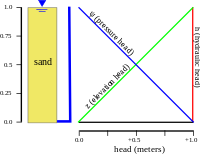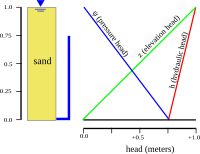Hydraulic head
This article includes a list of general references, but it lacks sufficient corresponding inline citations. (April 2020) |

Hydraulic head or piezometric head is a specific measurement of
It is usually measured as a liquid surface elevation, expressed in units of length, at the entrance (or bottom) of a
Definition
In
The static head of a pump is the maximum height (pressure) it can deliver. The capability of the pump at a certain RPM can be read from its Q-H curve (flow vs. height).
Head is useful in specifying centrifugal pumps because their pumping characteristics tend to be independent of the fluid's density.
There are generally four types of head:
- Velocity head is due to the bulk motion (kinetic energy) of a fluid.Note that is equal to theirrotational flow.
- Elevation head is due to the fluid's weight, the gravitational forceacting on a column of fluid. The elevation head is simply the elevation (h) of the fluid above an arbitrarily designated zero point:
- Pressure head is due to the static pressure, the internal molecular motion of a fluid that exerts a force on its container. It is equal to the pressure divided by the force/volume of the fluid in a gravitational field:
- Resistance head (or friction head or Head Loss) is due to the frictional forces acting against a fluid's motion by the container. For a continuous medium, this is described by Darcy's law which relates volume flow rate (q) to the gradient of the hydraulic head through the hydraulic conductivity K: while in a piped system head losses are described by theBernoulli’s equation.
Components
After free falling through a height in a vacuum from an initial velocity of 0, a mass will have reached a speed
The term is called the velocity head, expressed as a length measurement. In a flowing fluid, it represents the energy of the fluid due to its bulk motion.
The total hydraulic head of a fluid is composed of pressure head and elevation head.
- is the hydraulic head (Length in m or ft), also known as the piezometric head.
- is the pressure head, in terms of the elevation difference of the water column relative to the piezometer bottom (Length in m or ft), and
- is the elevation at the piezometer bottom (Length in m or ft)
In an example with a 400 m deep piezometer, with an elevation of 1000 m, and a depth to water of 100 m: z = 600 m, ψ = 300 m, and h = 900 m.
The pressure head can be expressed as:
- is the lbf/ft3),
- is the density of the liquid (Mass per unit volume, frequently kg·m−3), and
- is the gravitational acceleration (velocity change per unit time, often m·s−2)
Fresh water head
The pressure head is dependent on the density of water, which can vary depending on both the temperature and chemical composition (salinity, in particular). This means that the hydraulic head calculation is dependent on the density of the water within the piezometer. If one or more hydraulic head measurements are to be compared, they need to be standardized, usually to their fresh water head, which can be calculated as:
where
- is the fresh water head (Length, measured in m or ft), and
- is the density of fresh water (Mass per unit volume, typically in kg·m−3)
Hydraulic gradient
The hydraulic gradient is a
- is the hydraulic gradient (dimensionless),
- is the difference between two hydraulic heads (length, usually in m or ft), and
- is the flow path length between the two piezometers (length, usually in m or ft)
The hydraulic gradient can be expressed in vector notation, using the
In groundwater

|

|
The distribution of hydraulic head through an
Atmospheric pressure
Even though it is convention to use
The effects of changes in atmospheric pressure upon water levels observed in wells has been known for many years. The effect is a direct one, an increase in atmospheric pressure is an increase in load on the water in the aquifer, which increases the depth to water (lowers the water level elevation). Pascal first qualitatively observed these effects in the 17th century, and they were more rigorously described by the soil physicist Edgar Buckingham (working for the United States Department of Agriculture (USDA)) using air flow models in 1907.
Head loss
In any real moving fluid, energy is dissipated due to friction; turbulence dissipates even more energy for high Reynolds number flows. This dissipation, called head loss, is divided into two main categories, "major losses" associated with energy loss per length of pipe, and "minor losses" associated with bends, fittings, valves, etc. The most common equation used to calculate major head losses is the Darcy–Weisbach equation. Older, more empirical approaches are the Hazen–Williams equation and the Prony equation.
For relatively short pipe systems, with a relatively large number of bends and fittings, minor losses can easily exceed major losses. In design, minor losses are usually estimated from tables using coefficients or a simpler and less accurate reduction of minor losses to equivalent length of pipe, a method often used for shortcut calculations of pneumatic conveying lines pressure drop.[4]
See also
- Borda–Carnot equation
- Dynamic pressure
- Minor losses in pipe flow
- Total dynamic head
- Stage (hydrology)
- Head (hydrology)
- Hydraulic accumulator
Notes
- ^ ISBN 978-0849327674, 410 pages. See pp. 43–44.
- ^ ISBN 978-0750659789, 650 pages. See p. 22.
- ^ Streeter, Victor L. (1958) Fluid Mechanics, Section 3.7 (Fourth edition) McGraw-Hill
- ^ "Pipe equivalent length (Pneumatic conveying)".
References
- Bear, J. 1972. Dynamics of Fluids in Porous Media, Dover. ISBN 0-486-65675-6.
- for other references which discuss hydraulic head in the context of hydrogeology, see that page's further reading section


























